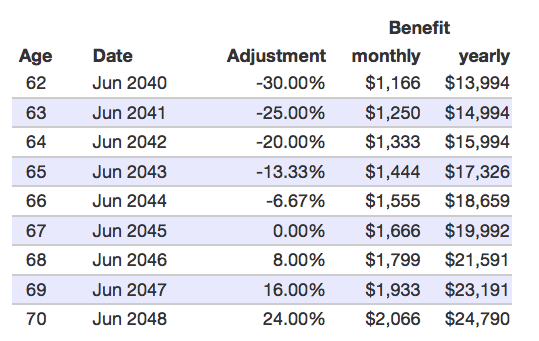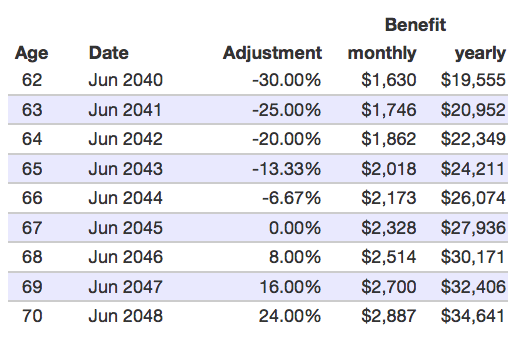 There are some (mostly young) skeptics, but Social Security should remain a major pillar of your future retirement income. For over 60% of current retirees aged 65+, Social Security makes up the majority of their income. Therefore, it may be worth spending some extra time figuring out how it works.
There are some (mostly young) skeptics, but Social Security should remain a major pillar of your future retirement income. For over 60% of current retirees aged 65+, Social Security makes up the majority of their income. Therefore, it may be worth spending some extra time figuring out how it works.
First, you should sign up for a mySocialSecurity account at SSA.gov. For many people, this is the only way to view your current benefit eligibility as they are phasing out those annual green paper statements. You will find some interesting information including eligible earnings history. (For example, I earned $1,814 in the summer after high school.) Also, if you claim your account first, it prevents an potential identity thief from opening an account in your name and stealing your benefits.
Second, you can check out this unofficial Social Security helper tool to test out different scenarios. Created by an Google engineer named Greg Grothaus in his spare time, the site takes your earnings history and uses Javascript to analyze it within your browser. No data is submitted over the internet. Found via The Finance Buff.
Here are some scenarios you might test out:
- What happens to my benefit if I earn additional wages for several more years? What if I stop working forever?
- How does my benefit change as my total earnings grow during my lifetime?
- What happens if I choose to take my benefits early? What if I delay and take them late?
You might not know that your eventual benefit is based on your top 35 annual indexed earnings values. Indexed earnings are simply the payroll wages you earned in a year multiplied by a number that adjusts for wage growth. I personally don’t even have 35 working years yet, so every additional year I work will be in my “Top35” and increase my future payout. Here are some charts based on my earnings history:
If I stop working immediately and then start taking benefits at my “normal” retirement age of 67 years, I will earn $1,666 per month ($19,992 per year). If I start taking money at age 62, I will earned a reduced $1,166 per month ($13,994 per year). Here’s the full chart:

If I keep working for another 20 years at $50,000 per year, then my age 67 benefit will increase to $2,328 per month ($27,936 per year). If I start taking money at age 62, I will earned a reduced $1,630 per month ($19,555 per year). Here’s the updated full chart:

Working/waiting an extra year may increase your payout enough to change your lifestyle significantly. An extra $100 per month may not seem that much, but that’s an extra $1,200 each year for the rest of your life that increases with inflation. If you don’t have adequate income from other sources, that could cover your medication copays for the year. It could be the difference between staying home and doing a video chat vs. flying and playing with your grandkids in person each year.
If you are on the early retirement track, that inserts a bunch of zeros in your “Top 35”. With this calculator, you can see how much that actually changes your eventual payout. Even if I continued to work another 25 years at $100,000 per year, my annual benefit at age 67 would be about $33,000 per year.
As a reminder, both SSA.gov and this tool only show you what your benefit will be under current law. Social Security isn’t a savings plan – current retirees are being paid from money taken from current workers. This means that changing demographics will require some sort of modification by 2035. From the Chief Actuary of the Social Security Administration:
Currently, the Social Security Board of Trustees projects program cost to rise by 2035 so that taxes will be enough to pay for only 75 percent of scheduled benefits. This increase in cost results from population aging, not because we are living longer, but because birth rates dropped from three to two children per woman. Importantly, this shortfall is basically stable after 2035; adjustments to taxes or benefits that offset the effects of the lower birth rate may restore solvency for the Social Security program on a sustainable basis for the foreseeable future.
 The Best Credit Card Bonus Offers – July 2024
The Best Credit Card Bonus Offers – July 2024 Big List of Free Stocks from Brokerage Apps
Big List of Free Stocks from Brokerage Apps Best Interest Rates on Cash - July 2024
Best Interest Rates on Cash - July 2024 Free Credit Scores x 3 + Free Credit Monitoring
Free Credit Scores x 3 + Free Credit Monitoring Best No Fee 0% APR Balance Transfer Offers
Best No Fee 0% APR Balance Transfer Offers Little-Known Cellular Data Plans That Can Save Big Money
Little-Known Cellular Data Plans That Can Save Big Money How To Haggle Your Cable or Direct TV Bill
How To Haggle Your Cable or Direct TV Bill Big List of Free Consumer Data Reports (Credit, Rent, Work)
Big List of Free Consumer Data Reports (Credit, Rent, Work)
It is hopeful that with adjustments the program can be stable and solvent after 2035. Congress will probably leave it until 2037 to do anything about it.
I believe there is a cap/max on benefits? The Social Security Administration (SSA) set the maximum amount of wages in 2017 subject to the 6.2% Social Security tax (old age, survivor, and disability insurance) at $127,200. Beyond that (current) number I don’t think you can expect to receive any additional money in retirement age.
I started working when I was 12 years old, selling ice cream at a car races, I earned a nickel for every ice cup that I sold., “ice cream, ice cream” and quit and retired when I was 70 years old, working my last job in the oil field and also working in the office! I started paying for Medicare around 1965.
I think another interesting issue to consider in these types of calculations is the cumulative amount of payments received in relation to filing age. Although you will certainly get a bigger payment the longer you wait to file, you also have to keep in mind you are that much closer to passing from this earth. I played around on an Excel spreadsheet using my 2017 SS benefits estimate and found that the “breakeven point” (in terms of total payments received) between filing at age 62 and waiting until age 67 is around age 79 for me.
So that presents quite a decision for early retirees. Do you postpone filing for social security in order to get a higher payment later on — hoping the regulations are not changed to your detriment — while drawing down your own assets for several years? Or do you file early to have a sure thing and keep more of your assets working — hoping the markets will be in your favor?
You can also use SSA’s anypia tool. It is a downloadable, locally installed tool where you enter your data and get benefit results (if you want to keep or do stuff off the web). It has updates every 6 months or so for new inflation data. It is not as spiffy as the Google one, but it does the job.
I started working when I was 12 years old, selling ice cream at a car races, I earned a nickel for every ice cup that I sold., “ice cream, ice cream” and quit and retired when I was 70 years old, working my last job in the oil field and also working in the office! I started paying for Medicare around 1965.
Jonathan, any plan on doing another post on spousal benefits?
That’s a good question, although I haven’t done enough research to feel comfortable writing a post about it. Have you? If so, would you like to do a guest post?
I’ve done some research, but I’m in the same boat. Definitely not qualified to do a post. Thanks!
Jonathan, since you wrote this post, the unofficial tool you linked to has undergone a major revision that includes a spousal benefit calculation. If you have any questions about the results, let me know, happy to try to answer them as best as I can.
Another day another Ponzi scheme, another theft of taxpayer money, another mismanaged program whose only promise is to leave a lot of people in the dust. Between Reagan and Clinton’s the US Government managed to steal $5 Trillion from the Social Security Trust. They did this with the assistance of the ever pliant Anything But Dept. of Justice who wrote a memo saying that the TRUST was not a trust. And though these funds are not tax money and do not belong to the government for general obligation uses like fighting illegal wars the money was stolen and replaced with US Government debt that, no longer AAA of course and if you can believe it there is a clause in the bonds that says the government does not have to honor or pay the bond each time Social Security has to cash them in to pay benefits. Who needs George Orwell or Bernie Madoff when you have two criminal front organizations managing the government. My advice to all is….take what you can while the taking is good…everything else is noise and manipulation.
thanks for this helpful article. made me FINALLY create an account at SSA, been putting it off for years.
nifty helper tool as well.
I saw your article and went around checking myself and my wife’s. I found it interesting that pre-tax deductions (besides 401k) came out of my SSA income….So since I take all of our pre-tax deductions out of my checks, my income is reported substantially lower than my gross. In the end, I don’t know how much it matters for my own situation however I could see a scenario where it would make sense to put some thought into how you’re splitting your deductions (or not).
Another thing to think about is if you have one earner with higher income than the other, you may want to shift all of your pre-tax deductions off the higher earners paycheck if that would help them reach the max, thus costing you less every year. Here’s an example: One makes $50k, the other makes $150k, if deductions bring $150k down to $125k, then you pay 6.2% on $175k as a couple. If you shift the same $25k in deductions to $50k, then you pay on $25k + $127.2k (max) = $152.2k, hypothetically saving roughly $1,400.
I believe it’s absolute fraud that you have to work until you’re almost dead to receive money that you worked hard to earn and the very little payback you get in return is absurd, leaving most 62-67 year olds to continue work till they actually die, 1200-1600 a month no one in America can survive or retire living from that, I am 41 years old I have 44 credits enough to retire but will have to work almost another 40 years and the retirement SSI will still be the same regardless why can’t people who have earned the credits start receiving there retirement funds and have those years to live while they can, don’t tell me it’s we don’t have the money ….billions being sent to other countries….people will eventually just stop paying taxes and say forget SSI it’s not worth it…